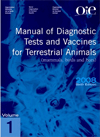African Horse sickness
The book Manual of Diagnostic Test and Vaccines for Terrestrial Animals edited by World Organisation for Animal Health (OIE) includes this chapter
January 1st, 2008
African horse sickness (AHS) is an infectious but noncontagious viral disease affecting all species of equidae caused by an orbivirus of the family Reoviridae and characterised by alterations in the respiratory and circulatory functions. AHS is transmitted by at least two species of Culicoides. Nine different serotypes have been described.
All serotypes of AHS occur in eastern and southern Africa. Only AHS serotype 9 and 4 have been found in West Africa from where they occasionally spread into countries surrounding the Mediterranean. Examples of outbreaks that have occurred outside Africa are: in the Middle East (1959–1963), in Spain (serotype 9, 1966, serotype 4, 1987–1990), and in Portugal (serotype 4, 1989).
Laboratory diagnosis of AHS is essential. Although the clinical signs and lesions are characteristic, they can be confused with those of other equine diseases.
As a viral disease, the laboratory diagnosis of AHS can be based on the identification of infectious virus, virus nucleic acid, viral antigens or specific antibodies. Over the past few years, a wide variety of laboratory tests have been adapted for the detection of both AHS virus (AHSV) and specific antibodies.
Identification of the agent: it is important to perform virus isolation and serotyping whenever outbreaks occur outside the enzootic regions.
AHSV can be isolated from blood collected during the early febrile stage. For virus isolation, the other tissues of choice for diagnosis are spleen, lung, and lymph nodes, collected at necropsy. Sample preparations can be inoculated in cell cultures, such as baby hamster kidney-21 (BHK-21), monkey stable (MS) or African green monkey kidney (Vero), intravenously in embryonated eggs,
and intracerebrally in newborn mice. Several enzyme-linked immunosorbent assays (ELISAs) for the rapid detection of AHSV antigen in spleen tissues and supernatant from infected cells have been developed. Identification of AHSV RNA has also been achieved using a reverse-transcription polymerase chain reaction method. Virus isolates can be serotyped by a type-specific serological test such as virus neutralisation (VN) and by reverse-transcription polymerase chain reaction and sequencing.
Serological tests: Horses that survive natural infection develop antibodies against the infecting serotype of AHSV within 8–12 days post-infection. This may be demonstrated by several serological methods, such as complement fixation test, ELISA, immunoblotting and VN. The latter test is used for serotyping. Other tests that have been described are immunodiffusion and haemagglutination inhibition.
Requirements for vaccines and diagnostic biologicals: Attenuated (monovalent and polyvalent) live vaccines for use in horses, mules and donkeys, are currently commercially available. A monovalent inactivated vaccine has been produced commercially, but is no longer available. New vaccines, including a subunit vaccine, have been evaluated experimentally
 | Servicio de Inmunología Viral y Medicina Preventiva (SUAT). Centro de Vigilancia Sanitaria Veterinaria (VISAVET). Universidad Complutense (UCM). 111 |
 | Departamento de Sanidad Animal. Facultad de Veterinaria. Universidad Complutense (UCM). 111 |

